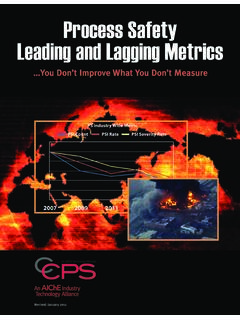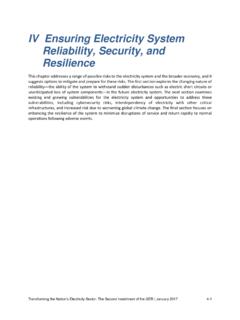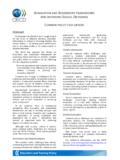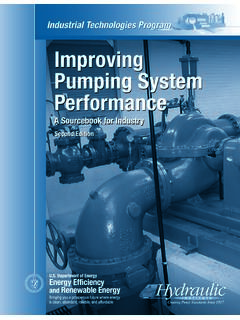Transcription of Develop a Maintenance and Reliability Plan
1 38 June 2015 CEPP lant OperationsRather than performing a critical evaluation of their Maintenance plans, many companies in the chemical process industries (CPI) replace malfunctioning or dated equipment with the latest technology. However, new technology only enables an ineffective Maintenance program to be more efficient at being ineffective. The goal of a main-tenance and Reliability program is to deliver a proper balance of Maintenance activities primarily those aimed at iden-tifying impending failures to allow for timely corrective actions. The optimal Maintenance and Reliability program for a plant provides the right Maintenance on the right assets at the right time. After years of operating, many CPI plants lose track of the main goals of their Maintenance program. For example, after experiencing a rare equipment failure, a plant instituted frequent inspections aimed at preventing the recurrence of that failure a significant burden on the Maintenance staff.
2 Thus, the Maintenance program changed from one of coordinated and well-thought-out preventive behavior to one of knee-jerk reactionary behavior. By understanding which assets are most important (right assets), what should be done to restore or maintain the inherent Reliability of those assets (right Maintenance ), and at what frequency those actions should be taken (right time), a Maintenance organization can become more effective and more efficient and often reduce costs significantly. This article looks at how plant Maintenance organizations in the CPI can re-evaluate and restructure their Maintenance and Reliability plans to incorporate industry best practices. Establishing or re-establishing a Maintenance and reli- ability program involves the following basic steps: 1. Create a snapshot of the organization.
3 2. Develop a plan and a strategy for implementing it. 3. Prioritize assets within the plant. 4. Define Maintenance requirements. 5. Allocate personnel resources. 6. Deploy tools (technology and/or software). 7. Measure success and continuously improve. These actions serve as the building blocks to redefine the plant s Maintenance program and to help build a sustainable proactive organization to minimize costs and improve reli- ability and availability of plant assets. Create a snapshot of the organization To determine how to get to your destination, you need to know where you are beginning. A plant can gauge the current status of its Maintenance program in many ways, such as by industry benchmarking, through surveys, or using a trial-and-error approach. One way is to measure performance against a set of best practices, as illustrated by the example in Figure 1.
4 This organization s performance on 21 elements of a best-practice Maintenance program was rated on a scale of 1 to 10, and these ratings were plotted on a spider chart. In this assessment, scores of 8 10 are considered world-class performance. An analysis such as this is typically conducted by a third party, who facilitates a series of interviews with personnel at all levels of the corporation. The evaluator asks ques-tions about each of the elements, documents the answers, compares answers across interviewees, and determines an average rating for each element. The results are compared to An effective Reliability program provides the right Maintenance on the right assets at the right ArmitageThe Reliability Optimization a Maintenance and Reliability PlanCopyright 2015 American Institute of Chemical Engineers (AIChE)CEP June 2015 39a set of standards that has been developed to describe a best-practice organization.
5 This is an excellent way for manage-ment to get feedback on the real issues, both good and bad, affecting the organization s Maintenance program. The facility described by Figure 1 has some room for improvement in its use of work management systems and information integration systems. It seems to have good Maintenance and diagnostic technologies in place, but its integration of that information into the identification, plan-ning, scheduling, and execution of work needs improve-ment. With regard to management and work culture, accountability and organizational skills are good, but there is room for improvement in goal setting, global metrics, and developing continuous improvement plans. Finally, more emphasis should be placed on personnel training, which may have a significant positive impact on some of the other areas.
6 The gaps between the plant s ratings and the values corresponding to world-class performance (gray areas) represent opportunities for a plan for improvement By focusing on the lower ratings in its snapshot, the organization can Develop a plan to close the gaps and raise its performance on key metrics, thereby improving its overall performance. This step may include planning for training, developing and optimizing procedures, improving communications, integrating software systems, realigning organizational structures, reallocating manpower, etc. The plan should rank the plant s assets based on how critical they are to the business, and then optimize the associated Maintenance tasks based on those rankings. The specifics of the plan will depend on the direction and goals of the company. An action plan for the example in Figure 1 might include: Prioritize all plant assets by assigning each an objective and relative ranking based on what is business-critical to plant operations and asset availability.
7 Optimize current preventive Maintenance (PM) plans based on the relative criticality of assets to support plant availability needs. Optimize the workflow and define responsibilities for identifying and planning work. Provide training to enable employees to better utilize the computerized Maintenance management system (CMMS) and integrate diagnostic-technology data into the CMMS. Establish a feedback loop for all work orders to evalu- Utilization Work Processes Technology Expertise Managment and Work Culture Work Order Close-OutMaintenance and Diagnostics Te chnologiesContinuous Improvement MethodsGlobal Metrics and ReportingPlantwide CommunicationsQualifications/Job DescriptionsDepartmental CommunicationsTrainingBenchmarkingGoal SettingLeadershipOrganizationAccountabil ityInformation Integration SystemsWork Management SystemsWork ExecutionWork SchedulingSpare PartsWork PlanningWork p Figure 1.
8 To create a snapshot of a plant s Maintenance program, the plant s current performance is assessed, compared to a set of best practices, and plotted on a spider chart. The gaps between the plant s rating and the value associated with world-class performance (gray region) represent improvement 2015 American Institute of Chemical Engineers (AIChE)40 June 2015 CEPP lant Operationsate lessons learned and to help refine standard job plans for continuous improvement. Develop goals that are aligned with Maintenance objec-tives and relevant to the workforce. Make those goals visible to employees. Provide refresher training to ensure that all personnel have up-to-date plant assets The next step is to execute the plan, which typically starts with taking an objective look at the relative critical-ity of assets in a particular area or system.
9 Operations and Maintenance personnel should collaborate to define the basic functional systems and the associated assets (or group of assets) that work together to achieve a specific function. Fortunately, much of this work is often completed as part of a CMMS implementation. One way to prioritize plant assets for Maintenance is to assign a reliabiltiy optimization ranking (ROR) to each asset, as shown in Figure 2. This method starts by determining the system-criticality ranking (SCR) of each subsystem based on the impact its failure would have on safety, the environment, annual repair costs, product throughput, and product quality. The SCR is an average of these five factors, and is a number from 1 to 10, with 10 being the most critical subsystem (fail-ure would have a big impact) and 1 being the least critical (failure would have little to no impact) to plant output.
10 Then, determine the production- criticality ranking (PCR) of each asset within the subsystem. The PCR is the impact the asset has on the function of its parent system. This will help you define where you have single- point failures in your plant (versus redundancy). The PCR is a ranking between 1 and 10, with 10 being an asset with high criticality to the functioning of its parent system. Next, calculate the business-criticality ranking (BCR) of each asset by multiplying the subsystem s SCR by the asset s PCR. After a functional failure occurs, the BCR will enable you to prioritize repair work. The assets with the highest BCR values should be repaired first. The assets that rank highest on the BCR list might not be the assets that require the most Maintenance . Not all assets have the same likelihood of failure.


















